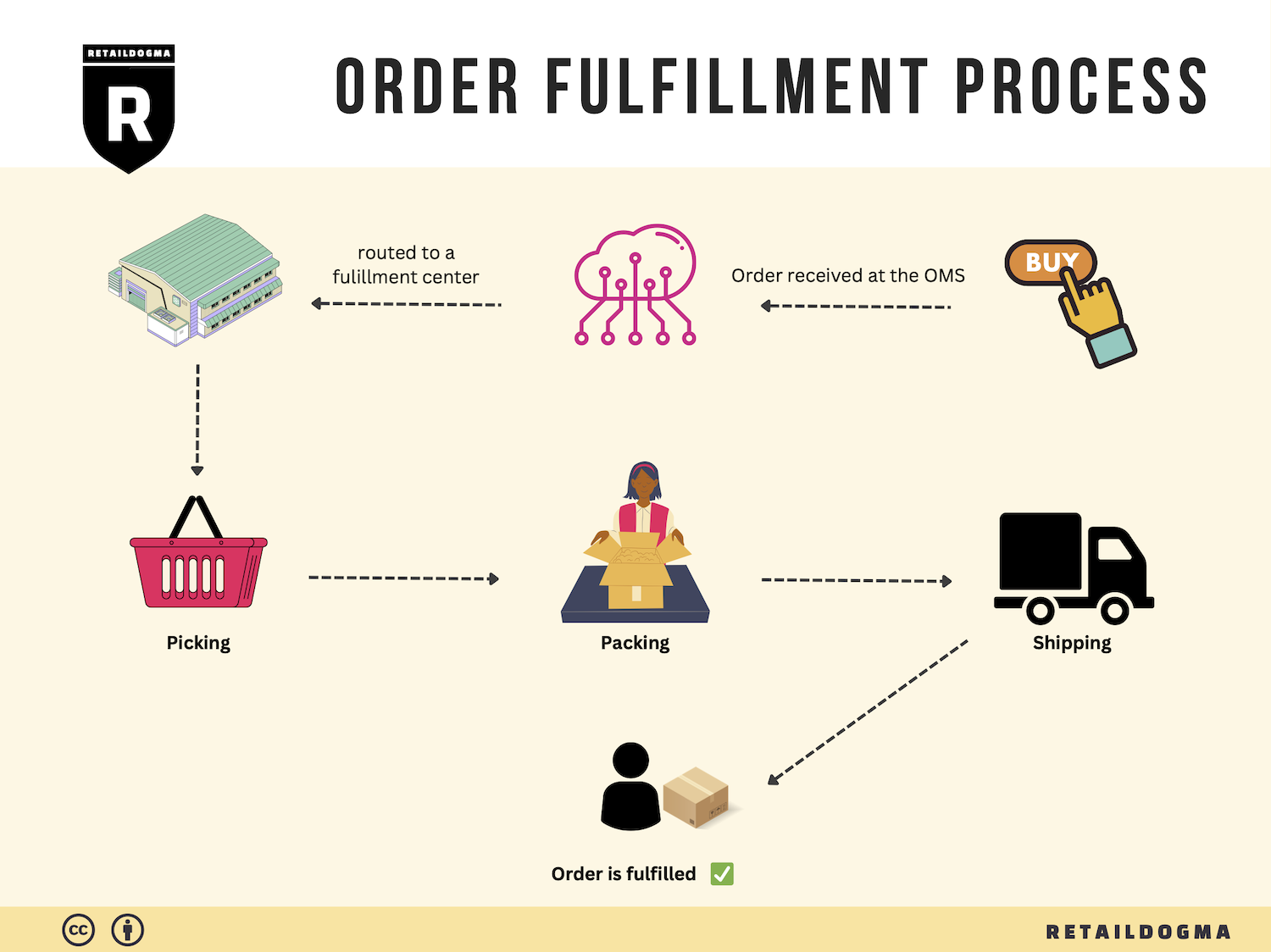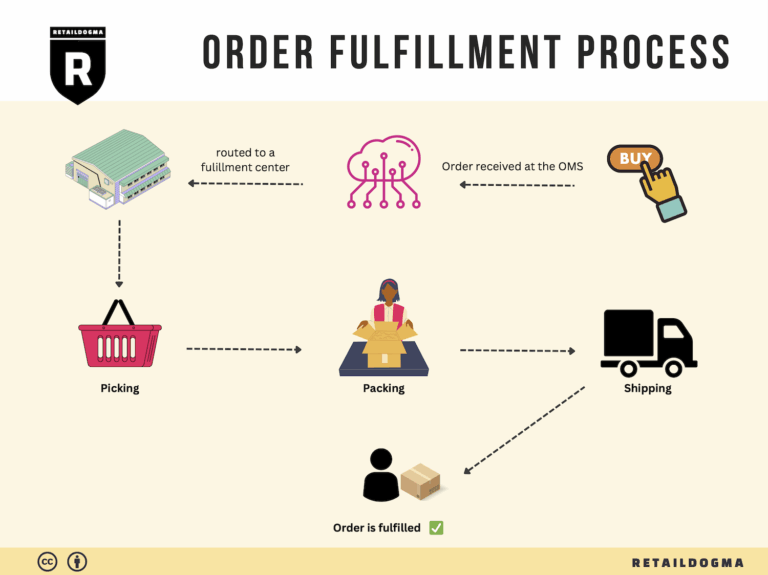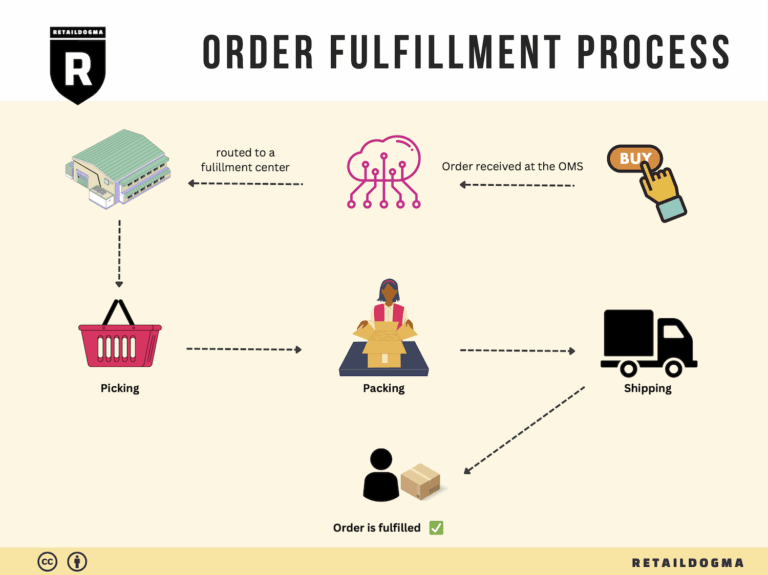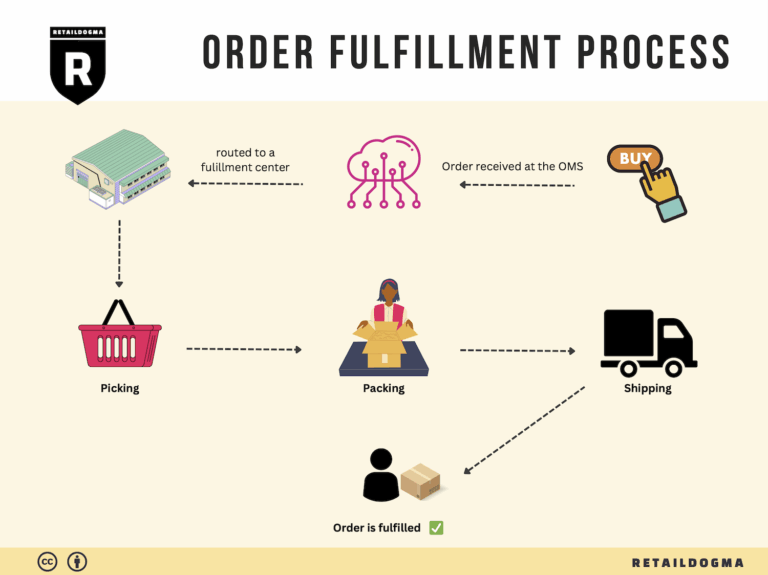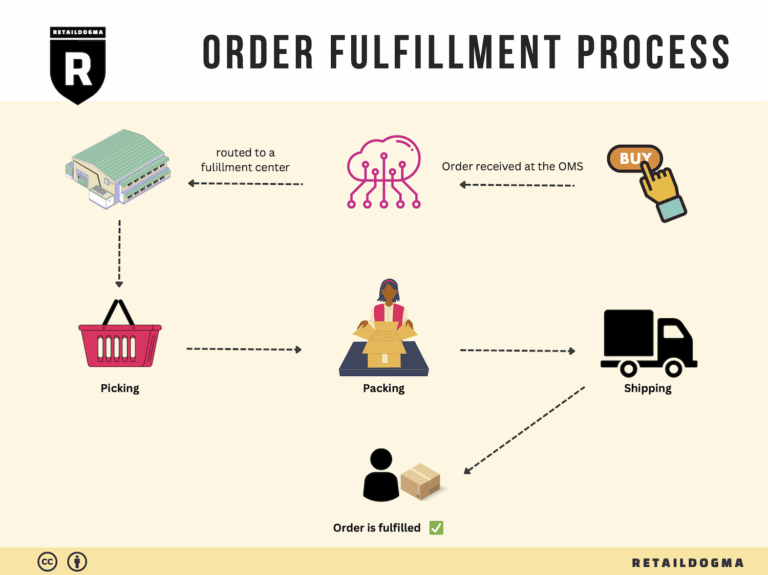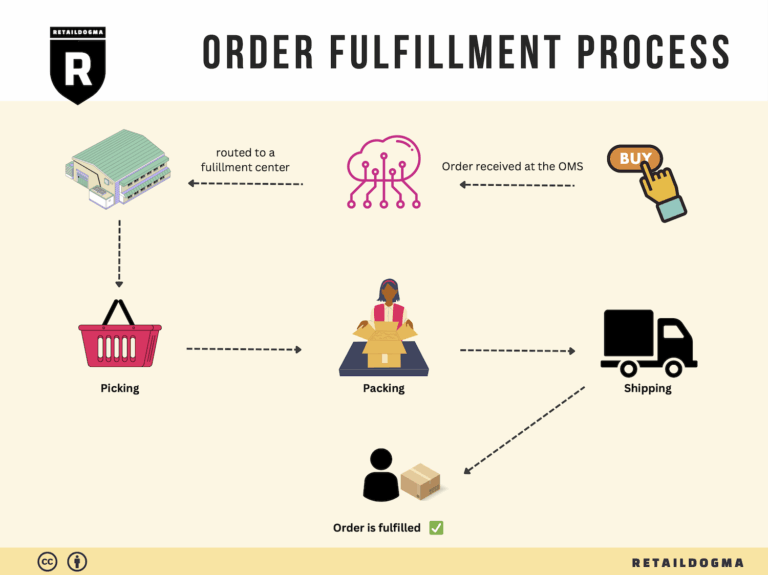Ecommerce Fulfillment Services: The Ultimate Guide (2025)
What is E-commerce Fulfillment? An Introduction for Growing Businesses
Understanding E-commerce Fulfillment
As an e-commerce business owner, you might find yourself overwhelmed by the demands of packing and shipping orders. In the early days, it can be manageable to handle this in-house, but as your sales grow, so do the complexities of fulfillment. The process of getting a product to a customer—known as fulfillment—can quickly become a daunting task that distracts you from your core business activities, such as product development and marketing.
E-commerce fulfillment encompasses all the steps necessary to deliver a product to your customer, from receiving inventory and storing it, to picking, packing, and shipping orders. Efficient fulfillment is crucial for maintaining customer satisfaction and ensuring timely delivery, both of which are essential for scaling your business. In this guide, we’ll explore various fulfillment models, such as Third-Party Logistics (3PL) and Fulfillment by Amazon (FBA), which can help streamline your operations.
What This Guide Will Cover
We will delve into the core services that fulfillment partners typically offer, including:
- Warehousing and Storage: Understanding how to manage your inventory effectively and the importance of storage solutions.
- Pick and Pack Services: Discovering how orders are efficiently picked and packed to meet customer expectations.
- Shipping Solutions: Evaluating options for shipping that balance cost and speed, including international shipping considerations.
- Returns Management: Learning how to handle returns gracefully to maintain customer trust and satisfaction.
Additionally, we will provide insights on how to choose the right fulfillment partner for your specific needs. Factors such as service offerings, integration capabilities with your e-commerce platform, and customer support will be highlighted to help you make an informed decision.
Navigating Pricing Structures
Understanding the pricing models of fulfillment services is vital for budgeting and forecasting. We will discuss common pricing structures, potential hidden costs, and how to assess the overall value of a fulfillment partner relative to their services.
Empowering Smart Logistics Decisions
The goal of this guide is to empower you to make informed decisions about your logistics strategy. Whether you are a startup looking to scale or an established business aiming to optimize your operations, the insights provided here will help you navigate the complexities of e-commerce fulfillment with confidence. By choosing the right partner and understanding the fulfillment landscape, you can focus on what you do best—growing your business.
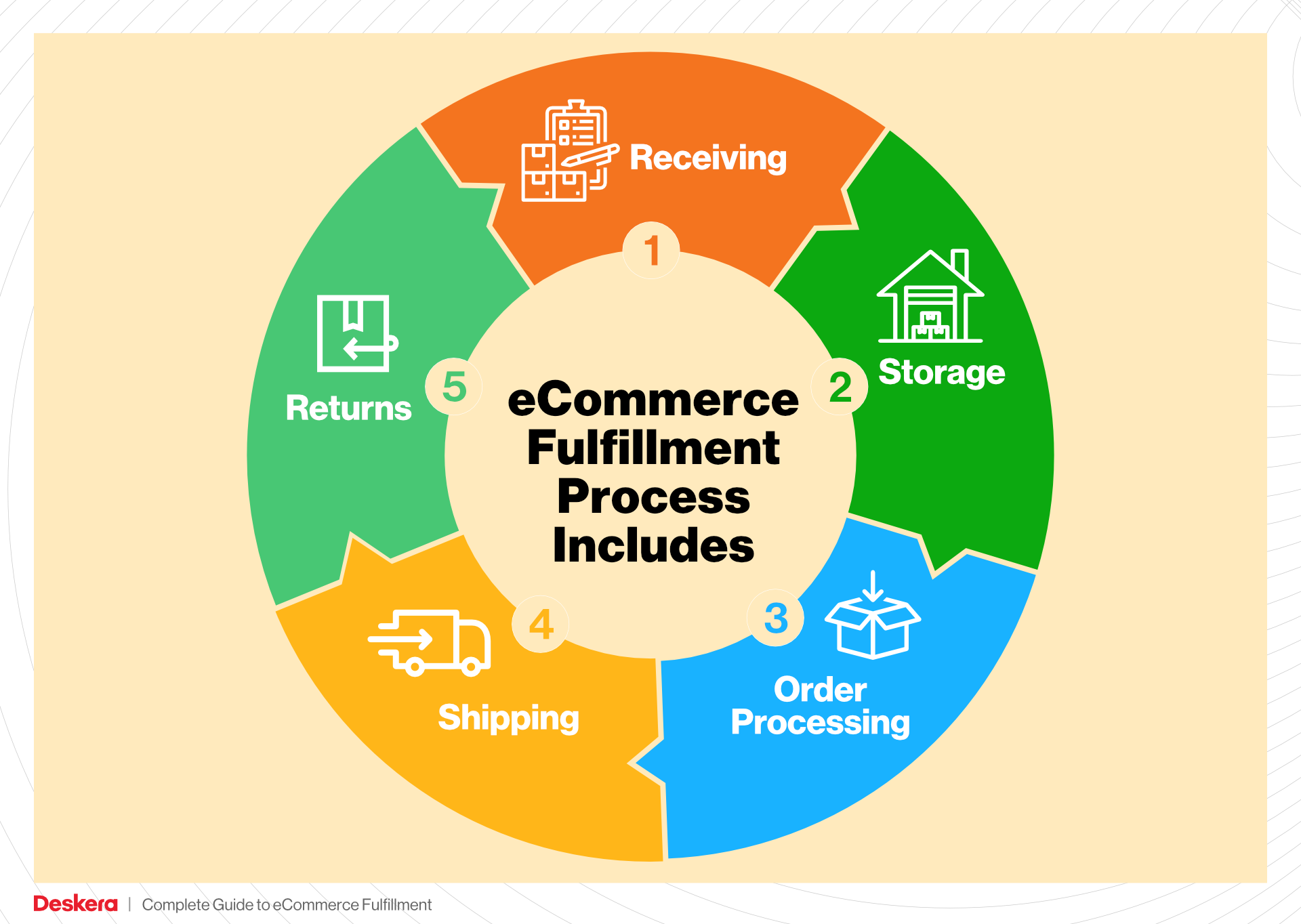
What You’ll Learn In This Guide
- What is E-commerce Fulfillment? An Introduction for Growing Businesses
- The Order Fulfillment Process: From ‘Buy’ Button to Customer’s Door
- Comparing Fulfillment Models: In-House vs. 3PL vs. Dropshipping
- A Deep Dive into Amazon FBA: Pros, Cons, and Who It’s For
- Core Services Offered by Fulfillment Centers
- How to Choose a Fulfillment Partner: A 6-Point Checklist
- Understanding Fulfillment Pricing: A Breakdown of Common Fees
- Frequently Asked Questions (FAQs) about Fulfillment
- Conclusion: Is Outsourcing Fulfillment the Right Move for Your Business?
- Important Disclaimer
The Order Fulfillment Process: From ‘Buy’ Button to Customer’s Door
1. Receiving Inventory
The order fulfillment process begins with receiving inventory. This step is crucial as it sets the foundation for all subsequent operations. When products arrive at the fulfillment center, they are checked against purchase orders to ensure accuracy in quantity and condition. This process typically involves assigning a Stock Keeping Unit (SKU) to each product, which serves as a unique identifier for inventory management.
Why is this important? Accurate receiving helps to minimize discrepancies that can lead to stockouts or overstock situations, which can negatively impact customer satisfaction and cash flow. Efficient inventory management at this stage ensures that products are ready for quick retrieval when orders come in. Moreover, implementing a robust receiving system can streamline the entire fulfillment operation, allowing for more accurate forecasting and inventory control.
2. Warehouse Storage
Once inventory is received, the next step is warehouse storage. Products are strategically placed within the fulfillment center to optimize space and facilitate easy access. This is where effective inventory management systems (IMS) come into play, allowing businesses to track inventory levels and locations in real-time.
The importance of this step cannot be overstated. Proper organization ensures that items are easy to locate, reducing the time taken to pick orders and increasing overall efficiency. Additionally, effective warehouse storage minimizes the risk of damage and loss, ensuring that products remain in sellable condition. Businesses can also implement various storage methods, such as pallet racking or bin storage, depending on the size and nature of their products, to maximize space utilization.
3. Order Picking
When a customer places an order, the next critical step is order picking. This involves retrieving the correct items from the warehouse to fulfill the order. Order picking typically utilizes pick lists, which are generated based on the orders received. These lists guide warehouse staff to the specific locations of each item, ensuring accuracy and speed.
This step is vital for maintaining a high level of order accuracy and customer satisfaction. Efficient picking processes can significantly reduce the time taken to fulfill orders, which is crucial in today’s fast-paced e-commerce environment. Techniques such as batch picking (where multiple orders are picked simultaneously) or zone picking (where different staff members are responsible for different sections of the warehouse) can further enhance efficiency.
4. Order Packing
After items have been picked, the next step is order packing. This process involves carefully packing the selected items to ensure they arrive at the customer’s door in perfect condition. Packing materials such as boxes, cushioning, and tape are used to secure the products, and this is also the stage where branding can be incorporated, such as including personalized messages or branded packaging.
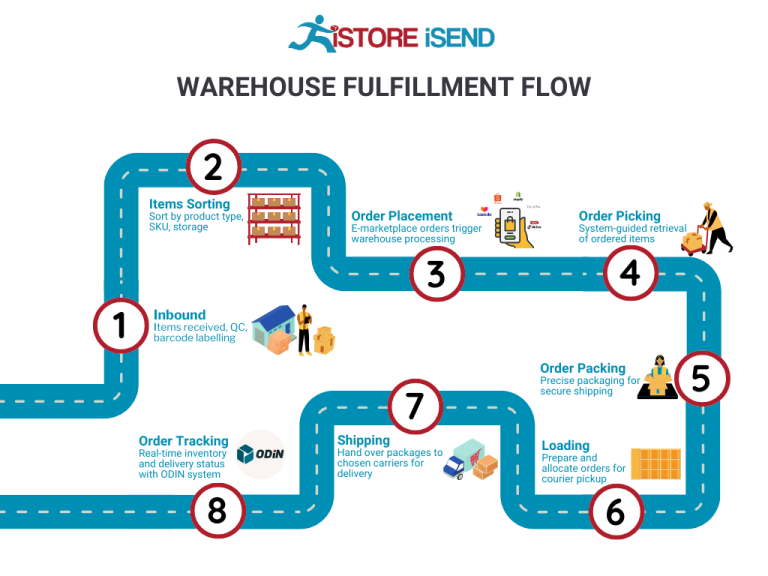
The importance of this step lies in the customer experience. Well-packed orders not only protect the items during transit but also create a memorable unboxing experience that can enhance customer loyalty. Additionally, implementing efficient packing processes can help reduce shipping costs by ensuring that the packaging is appropriate for the size and weight of the order, thereby minimizing dimensional weight charges.
5. Shipping & Delivery
The final step in the order fulfillment process is shipping and delivery. Once orders are packed, they are labeled and handed over to shipping carriers. Businesses often work with multiple carriers (e.g., USPS, UPS, FedEx) to find the best shipping rates and delivery times. This phase also involves providing customers with tracking information to keep them informed about their order’s status.
Shipping and delivery are critical as they directly impact customer satisfaction and retention. Timely and reliable shipping can differentiate your business from competitors, especially in an era where consumers expect quick delivery. Moreover, a streamlined shipping process can enhance operational efficiency and reduce shipping costs, contributing to overall profitability.
In summary, understanding and optimizing each step of the order fulfillment process—from receiving inventory to shipping and delivery—can significantly enhance a business’s operational efficiency, customer satisfaction, and ultimately, its bottom line. By focusing on these key areas, e-commerce businesses can scale effectively and maintain a competitive edge in the marketplace.
Comparing Fulfillment Models: In-House vs. 3PL vs. Dropshipping
Fulfillment Model Comparison
| Model | Who Handles Inventory | Best For (Business Stage) | Key Advantage | Key Disadvantage |
|---|---|---|---|---|
| In-House Fulfillment | Business Owner/Staff | Established Businesses | Full control over operations | High overhead costs and complexity |
| Third-Party Logistics (3PL) | 3PL Provider | Startups to Medium-Sized Businesses | Scalability and reduced labor costs | Less control over inventory management |
| Dropshipping | Supplier | New Entrepreneurs and Startups | Minimal upfront investment | Lower profit margins and potential quality issues |
In-House Fulfillment
In-house fulfillment involves managing all aspects of the fulfillment process within your own business. This includes inventory management, order processing, packing, and shipping. Businesses that adopt this model typically do so when they have established their operations and have sufficient resources to handle logistics internally. The primary advantage of in-house fulfillment is the complete control it provides over every aspect of the operation, from inventory management to shipping times and customer service. This can lead to enhanced customer satisfaction as businesses can tailor the fulfillment process to their specific needs. However, this model comes with significant downsides. It requires a considerable investment in warehousing, staffing, and technology, which can create high overhead costs. Additionally, as order volume grows, the complexity of managing fulfillment in-house can lead to inefficiencies and a strain on resources. As a business scales, the demands of in-house fulfillment may become overwhelming, prompting a reevaluation of this approach.
Third-Party Logistics (3PL)
Third-party logistics (3PL) providers offer comprehensive fulfillment services, allowing businesses to outsource their logistics operations. This model is particularly beneficial for startups and medium-sized businesses that seek to scale without the burden of managing fulfillment in-house. With a 3PL, companies can leverage the provider’s expertise, technology, and existing infrastructure to streamline operations. Key advantages of 3PL include reduced labor costs, access to advanced technology for inventory management, and the ability to quickly scale operations in response to fluctuating demand. 3PL providers often have established relationships with shipping carriers, which can lead to lower shipping costs and faster delivery times. However, one of the notable drawbacks is the potential loss of control over inventory management and the fulfillment process. Businesses must rely on their 3PL partner’s efficiency and accuracy, which can be a concern, especially if the provider does not align with the company’s standards. Furthermore, any disruptions in the 3PL’s operations can directly impact a business’s ability to fulfill orders, making it crucial to choose a reliable partner.
Dropshipping
Dropshipping is a fulfillment model where the retailer does not keep products in stock but instead transfers customer orders and shipment details to a supplier, who then ships the products directly to the customer. This model is especially attractive to new entrepreneurs and startups due to its minimal upfront investment and low risk. Since there is no need to purchase inventory upfront or manage storage, businesses can focus on marketing and sales. Additionally, dropshipping allows for a broad product range without the financial burden of holding stock. However, there are significant disadvantages to consider. The most notable is the lower profit margins, as suppliers often charge higher prices for their services. Quality control can also be a concern; since businesses rely on third-party suppliers for product quality and shipping, any issues can lead to customer dissatisfaction and damage to the brand’s reputation. Furthermore, with many businesses using dropshipping, competition can be fierce, making it challenging to differentiate in a crowded market. Overall, while dropshipping can be a great entry point into e-commerce, it requires careful supplier selection and effective marketing strategies to succeed.
A Deep Dive into Amazon FBA: Pros, Cons, and Who It’s For
Understanding Fulfillment by Amazon (FBA)
Fulfillment by Amazon (FBA) is a service provided by Amazon that allows sellers to store their products in Amazon’s fulfillment centers. Amazon takes care of storage, packaging, shipping, and customer service on behalf of the sellers. This service enables businesses to leverage Amazon’s vast logistics network and customer base, providing a streamlined way to sell products online.
How FBA Works
-
Setting Up: Sellers start by creating an Amazon seller account and enrolling in the FBA program. Once enrolled, they can list products for sale on Amazon.
-
Shipping Inventory: Sellers send their products to Amazon’s fulfillment centers. Amazon provides guidelines on how to prepare and package items to ensure they meet their requirements.
-
Storage and Fulfillment: Once the inventory is received, it is stored in Amazon’s warehouses. When a customer places an order, Amazon picks, packs, and ships the product directly to the customer.
-
Customer Service: Amazon handles all customer service inquiries, including returns and refunds, freeing sellers from these responsibilities.
-
Tracking and Reporting: Sellers have access to detailed reports and analytics, allowing them to monitor sales performance and inventory levels in real-time.
Pros of Using FBA
Prime Eligibility
One of the most significant advantages of using FBA is the ability to offer products with Amazon Prime eligibility. This status appeals to millions of Prime members who are more likely to purchase items that come with free two-day shipping, significantly increasing the chances of sales.
Customer Trust
Amazon is a trusted platform, and using FBA can enhance a seller’s credibility. Customers often feel more comfortable purchasing from sellers who use FBA because they trust Amazon’s customer service and return policies. This trust can lead to higher conversion rates and repeat customers.
Multi-Channel Fulfillment
FBA also supports multi-channel fulfillment, allowing sellers to use Amazon’s logistics capabilities for orders placed outside of Amazon, such as through their own website or other marketplaces. This flexibility helps businesses streamline their operations and manage inventory more effectively.
Cons of Using FBA
High Fees
While FBA offers numerous benefits, it comes with associated costs. Sellers must pay for storage and fulfillment fees, which can significantly cut into profit margins, especially for low-priced items. It’s essential to calculate these fees carefully to ensure that the overall business model remains profitable.
Strict Inventory Rules
Amazon has strict inventory management policies that sellers must adhere to. This includes guidelines on how products should be packaged, labeled, and stored. Failure to comply can result in additional fees or even suspension of seller accounts. Moreover, Amazon may impose limits on the number of units a seller can send to their fulfillment centers, which can hinder growth.
Commingling Risks
FBA operates on a commingling model, meaning that products from multiple sellers can be stored together in the same warehouse. This poses a risk for sellers, as they may receive returns that are not their own products. Commingled inventory can lead to customer dissatisfaction and negatively impact seller ratings if customers receive the wrong items.
Who is FBA Best For?
Fulfillment by Amazon is particularly advantageous for businesses that:
-
Have High Sales Volume: Companies with a high turnover rate can benefit from Amazon’s logistics and customer service, allowing them to focus on product sourcing and marketing.
-
Sell Consumer Goods: FBA is ideal for sellers of consumer goods that appeal to a broad audience, particularly those who can capitalize on Prime membership benefits.
-
Are New to E-commerce: Start-ups and new sellers can leverage Amazon’s infrastructure to establish their presence without the need to invest heavily in logistics and fulfillment processes.
-
Want to Expand Reach: Brands looking to scale quickly and reach a global audience can utilize FBA’s extensive distribution network to enhance their visibility and sales potential.
In conclusion, while Fulfillment by Amazon offers significant advantages like enhanced customer trust, Prime eligibility, and streamlined logistics, it also comes with challenges such as high fees and strict inventory management rules. Businesses should carefully evaluate their specific needs, sales volume, and product type before deciding if FBA is the right fulfillment solution for them.
Core Services Offered by Fulfillment Centers
Inventory Management & Warehousing
Inventory management and warehousing are foundational services offered by fulfillment centers, enabling e-commerce businesses to effectively store and oversee their stock. This involves not only the physical storage of products but also the tracking of inventory levels, order fulfillment rates, and stock replenishment needs.
What It Is: Fulfillment centers typically provide secure storage facilities where businesses can keep their products. Advanced inventory management systems integrate with e-commerce platforms to provide real-time updates on stock levels, allowing businesses to monitor inventory from anywhere.
Benefits to E-Commerce Businesses: Efficient inventory management ensures that businesses can meet customer demand without overstocking, which ties up capital and increases storage costs. Real-time tracking helps prevent stockouts, ensuring products are available when customers want them. Additionally, many fulfillment centers offer no long-term storage fees, making it cost-effective for businesses to scale without incurring hefty charges. Ultimately, a well-managed inventory system minimizes waste and maximizes sales potential.
Pick and Pack Services
Pick and pack services are essential for order fulfillment, transforming inventory into ready-to-ship packages. This process involves selecting the correct items from the warehouse (picking) and then packing them securely for shipment (packing).
What It Is: The fulfillment center’s staff is trained to efficiently pick items according to order specifications and pack them in a way that protects the products during transit. This can include using branded boxes, bubble wrap, and custom packing materials to enhance the customer experience.
Benefits to E-Commerce Businesses: The primary advantage of effective pick and pack services is the accuracy and speed of order fulfillment. High accuracy rates reduce the likelihood of returns and increase customer satisfaction. Faster processing times can also lead to quicker shipping, which is crucial in today’s competitive e-commerce landscape where consumers expect rapid delivery. By outsourcing this process, businesses can focus on core activities like marketing and product development rather than logistics.
Kitting and Assembly
Kitting and assembly services allow businesses to combine multiple products into a single package or kit, which can be particularly useful for promotional items or subscription services.
What It Is: This service involves assembling various components into a single product offering. For example, a subscription box service might require the assembly of themed kits that include several different items. Fulfillment centers handle all aspects of this process, from sourcing materials to final packaging.
Benefits to E-Commerce Businesses: Kitting can create unique selling propositions by offering customers bundled products at a better price than purchasing items individually. This not only enhances the customer experience but also increases average order value. Furthermore, it streamlines the shipping process by reducing the number of individual items sent out, ultimately lowering shipping costs. For businesses, having a reliable partner to manage kitting frees up resources and allows them to innovate on product offerings.
Returns Management (Reverse Logistics)
Returns management is a critical component of the fulfillment process, particularly in e-commerce where return rates can be as high as 30% in some sectors. Efficient reverse logistics can make or break customer satisfaction and loyalty.
What It Is: This service encompasses the entire process of handling returns, from the moment a customer initiates a return request to the inspection and restocking of returned items. Fulfillment centers typically manage the logistics of returns, including the processing of refunds or exchanges.
Benefits to E-Commerce Businesses: An effective returns management system enhances customer trust and satisfaction by simplifying the return process. A smooth returns experience can lead to repeat business, as customers are more likely to shop from brands that offer hassle-free returns. Additionally, by managing returns efficiently, fulfillment centers help maintain accurate inventory levels and reduce the costs associated with unsold returned goods. This not only improves cash flow but also allows businesses to analyze return data, providing insights into product issues or customer preferences.
In summary, partnering with a fulfillment center for inventory management, pick and pack services, kitting, and returns management can significantly enhance an e-commerce business’s operational efficiency. These core services not only streamline logistics but also contribute to a superior customer experience, ultimately supporting growth and scalability in a competitive market.
How to Choose a Fulfillment Partner: A 6-Point Checklist
Location & Warehouse Network
Choosing a fulfillment partner with strategically located warehouses is critical for optimizing shipping times and costs. The proximity of their facilities to your target markets can significantly impact delivery speed and customer satisfaction.
Why It’s Important:
– Shipping Costs: Closer warehouses can reduce shipping fees, especially for domestic orders.
– Delivery Speed: Faster delivery times enhance customer experience, potentially leading to repeat business.
Questions to Ask:
– Where are your warehouses located, and how do those locations align with my customer base?
– Do you have plans to expand your warehouse network in the near future?
– What is your average shipping time from each warehouse to major destinations?
Technology & Integrations
In today’s e-commerce landscape, having robust technology and seamless integrations is essential for efficient operations. Your fulfillment partner should offer a user-friendly system that integrates well with your existing e-commerce platforms.
Why It’s Important:
– Inventory Management: Real-time tracking helps you maintain optimal stock levels and avoid stockouts or overstock situations.
– Order Processing: Automated processes reduce errors and speed up fulfillment.
Questions to Ask:
– What systems do you use for inventory management and order fulfillment?
– Can your technology integrate with my existing e-commerce platform (e.g., Shopify, WooCommerce)?
– Do you offer real-time tracking for orders, and how can I access that information?
Specializations (e.g., Cold Storage, Oversized Items)
Your product type may require specific handling capabilities, such as temperature control for perishable goods or specialized storage for oversized items. Ensure your fulfillment partner has the necessary expertise and facilities.
Why It’s Important:
– Product Safety: Specialized handling reduces the risk of damage or spoilage.
– Compliance: Certain products may have regulatory requirements that need to be met.
Questions to Ask:
– What types of specialized fulfillment services do you offer (e.g., cold storage, hazardous materials)?
– How do you ensure compliance with industry standards for specialized products?
– Can you accommodate unique packaging or handling requirements for my products?
Scalability & Capacity
As your business grows, your fulfillment needs will likely change. A good partner should be able to scale their operations to meet your increasing demands without compromising service quality.
Why It’s Important:
– Flexibility: A scalable partner can adapt to seasonal spikes in demand or rapid growth phases.
– Long-term Partnership: Choosing a partner that can grow with you prevents the need for frequent changes, which can disrupt your operations.
Questions to Ask:
– How do you handle fluctuations in order volume during peak seasons?
– What is your current capacity, and how quickly can you scale up operations if needed?
– Can you provide examples of how you’ve supported other clients during their growth phases?
Pricing and Contracts
Understanding the pricing structure and contract terms is crucial to ensure you don’t face unexpected costs. Transparency in pricing helps you budget effectively and avoid surprises.
Why It’s Important:
– Cost Management: Clear pricing helps you maintain control over fulfillment expenses.
– Contract Flexibility: Flexible terms can prevent you from being locked into unfavorable conditions.
Questions to Ask:
– What is your pricing model (e.g., per order, storage fees, shipping costs)?
– Are there any hidden fees or additional costs I should be aware of?
– What are the terms regarding contract length, and is there an option for short-term agreements?
Customer Support & Reviews
Reliable customer support is invaluable in resolving issues quickly and effectively. Additionally, researching reviews and testimonials can provide insights into the partner’s reputation and reliability.
Why It’s Important:
– Issue Resolution: Strong customer support ensures that problems are addressed promptly, minimizing disruptions.
– Reputation Check: Reviews can highlight strengths and weaknesses, helping you make a more informed decision.
Questions to Ask:
– What customer support options do you provide (e.g., phone, email, chat)?
– Can you share client testimonials or case studies that reflect your customer service quality?
– How do you handle customer complaints or issues related to fulfillment?
Conclusion
Choosing the right fulfillment partner is a critical decision that can significantly impact your e-commerce operations. By evaluating potential partners based on location, technology, specializations, scalability, pricing, and customer support, you can make a more informed choice that aligns with your business goals. Remember to ask the right questions and assess how well a potential partner can meet your specific needs as you scale your business.
Understanding Fulfillment Pricing: A Breakdown of Common Fees
Initial Setup Fees
Initial setup fees are often the first costs associated with engaging a fulfillment service. These fees can cover a range of services, including account setup, integration with your e-commerce platform, and initial inventory processing. While some fulfillment providers may charge a significant fee for these services, many modern 3PL (third-party logistics) companies, such as eFulfillment Service, now offer zero setup fees as a competitive advantage.
When assessing initial setup fees, consider what is included in the package. For example, are there charges for software integrations, or is training provided for your staff? Understanding these elements can help you avoid unexpected costs and ensure a smooth transition to the fulfillment provider’s system.
Receiving Fees
Receiving fees are charged when your inventory arrives at the fulfillment center. These fees can vary based on the complexity of the receiving process, including the number of items, the condition of the products, and whether the items need to be inspected or sorted. Typically, receiving fees are calculated on a per-pallet or per-sku basis.
For example, if you send 100 boxes of various products, you might be charged a flat rate for each pallet received or a fee based on the number of unique SKUs. It’s essential to clarify these costs upfront, as they can add up quickly, especially during peak seasons when inventory turnover is high.
Storage Fees (per pallet/bin)
Storage fees are charged for the space your inventory occupies within the fulfillment center. These fees are typically calculated per pallet or per bin, depending on how your products are stored. The rate can vary based on the size of the pallet and the duration of storage.
For instance, some providers may offer tiered pricing, where the cost per pallet decreases as you store more pallets. Additionally, long-term storage fees may apply if your inventory remains in the warehouse for an extended period, such as over six months. When evaluating storage fees, consider your inventory turnover rate and how long you expect to keep products in storage to avoid unnecessary costs.
Pick & Pack Fees (per item/order)
Pick & pack fees are charged for the labor involved in selecting items from the warehouse and preparing them for shipment. These fees can be structured in various ways, typically calculated per item or per order.
For example, if a customer orders three different items, you might incur a fee for each item picked and packed. Some fulfillment centers offer a flat rate for orders up to a certain number of items, which can provide cost savings for larger orders. It’s crucial to understand how these fees are structured, as they can significantly impact your overall fulfillment costs, especially if your business involves frequent small orders.
Shipping Fees
Shipping fees cover the cost of transporting the packaged items to your customers. These fees can vary widely based on the shipping method selected (standard, expedited, etc.), the destination, and the weight of the package.
Many fulfillment services partner with major carriers, such as USPS, UPS, and FedEx, to negotiate competitive shipping rates. Some providers offer discounted shipping rates that can help reduce costs for your business. It’s advisable to compare these rates with your own shipping arrangements to determine the best option for your needs. Additionally, consider whether the fulfillment provider includes tracking and insurance in their shipping fees, as these features can add value.
Tips for Getting an Accurate Quote
-
Clarify Your Needs: Before requesting a quote, clearly define your business requirements, including expected order volume, product dimensions, and special handling needs.
-
Ask About Hidden Fees: Ensure you inquire about all potential fees, including setup, storage, and any additional services that may incur costs.
-
Get Detailed Estimates: Request a breakdown of costs associated with each service. This transparency will help you understand how fees are calculated.
-
Consider Seasonal Variability: If your business experiences seasonal fluctuations, discuss how your fulfillment costs might change during peak periods.
-
Evaluate Long-Term Contracts: Some providers offer lower rates for longer-term commitments. Weigh the benefits against your growth projections to make an informed decision.
By understanding these common fulfillment pricing models and asking the right questions, you can make informed decisions that will help your e-commerce business scale effectively while managing logistics costs.
Frequently Asked Questions (FAQs) about Fulfillment
1. What is merchandise fulfillment?
Merchandise fulfillment refers to the process of storing, packing, and shipping products to customers on behalf of an e-commerce business. It encompasses all logistics from inventory management to order processing and delivery, ensuring that customers receive their orders accurately and on time.
2. What is a 3PL (Third-Party Logistics) provider?
A 3PL provider is a company that offers outsourced logistics services, including warehousing, transportation, and order fulfillment. By partnering with a 3PL, e-commerce businesses can streamline their operations and focus on core activities such as marketing and product development while leaving logistics to the experts.
3. How do fulfillment services work?
Fulfillment services typically involve several key steps: receiving inventory, storing products in a warehouse or fulfillment center, processing orders as they come in, picking and packing items, and shipping them to customers. Many fulfillment providers also offer inventory management and return processing to enhance the overall service.
4. What’s the difference between a warehouse and a fulfillment center?
While both warehouses and fulfillment centers store products, their functions differ significantly. A warehouse primarily focuses on storage and inventory management, often for bulk products. In contrast, a fulfillment center specializes in processing customer orders, which includes picking, packing, and shipping, as well as managing returns and customer service interactions.
5. How much do fulfillment services cost?
The cost of fulfillment services can vary widely based on factors such as order volume, storage space needed, and the complexity of services provided. Typically, costs may include storage fees, picking and packing fees, shipping costs, and any additional service fees (like kitting or customization). It’s best to request quotes from multiple providers to find a solution that fits your budget.
6. What are the benefits of using a fulfillment service?
Utilizing a fulfillment service offers numerous advantages, including reduced operational costs, improved order accuracy, faster shipping times, and access to advanced logistics technology. Additionally, outsourcing fulfillment allows businesses to scale efficiently without the need for significant upfront investment in warehousing and staff.
7. Can fulfillment services handle international shipping?
Yes, many fulfillment services are equipped to manage international shipping. They typically partner with various carriers to navigate international logistics, customs regulations, and shipping costs. However, it’s essential to confirm this capability with your chosen provider to ensure they can meet your specific international shipping needs.
8. How do I choose the right fulfillment partner?
Selecting the right fulfillment partner involves assessing several factors: the provider’s experience and reputation, technology integration capabilities, shipping options, pricing structure, customer service responsiveness, and scalability to accommodate your business growth. It’s advisable to request references or case studies to gauge their performance.
9. What is inventory management in fulfillment?
Inventory management in fulfillment refers to the processes and systems used to track and manage stock levels, orders, and deliveries. A robust inventory management system helps e-commerce businesses monitor inventory in real-time, forecast demand, avoid stockouts, and optimize storage space, ensuring that products are available for timely order fulfillment.
10. How can I improve my fulfillment efficiency?
To enhance fulfillment efficiency, consider implementing automated inventory management systems, optimizing warehouse layout for faster picking, establishing clear communication channels with your fulfillment partner, and regularly reviewing performance metrics. Additionally, leveraging data analytics can help identify areas for improvement and streamline operations.
Conclusion: Is Outsourcing Fulfillment the Right Move for Your Business?
Evaluating the Benefits of Outsourcing Fulfillment
Outsourcing fulfillment can be a transformative strategy for e-commerce businesses looking to scale effectively. By partnering with a dedicated fulfillment service, companies can enjoy significant time savings, allowing them to focus on core business activities such as marketing, product development, and customer engagement. The logistics of storage, packing, and shipping are handled by experts, resulting in streamlined operations that enhance overall efficiency.
Scalability is another crucial advantage of utilizing fulfillment services. As your business grows, the demands on your logistics can increase exponentially. A reliable fulfillment partner can easily adapt to fluctuating order volumes, seasonal demands, and geographic expansions without the need for substantial investments in infrastructure or workforce. This flexibility ensures that you can meet customer expectations consistently, regardless of growth spurts or market changes.
Moreover, fulfillment services bring specialized expertise to the table. With years of experience in logistics, inventory management, and shipping, these partners can optimize your supply chain, reducing costs and improving service levels. They often have access to advanced technology and shipping networks that can enhance delivery speed and accuracy, ensuring customer satisfaction.
However, selecting the right fulfillment partner is vital for achieving these benefits. A thorough evaluation of potential providers, focusing on their track record, technology integration capabilities, and customer support, is essential for aligning with your business goals.
Take Action
To determine if outsourcing fulfillment is the right next step for your business, consider conducting an audit of your current shipping processes. Assess areas where inefficiencies occur, costs can be reduced, and customer experiences can be improved. Engaging with a fulfillment service could very well be the strategic move that propels your e-commerce business toward sustainable growth and operational excellence.
Important Disclaimer
⚠️ Important Disclaimer
The information in this guide is for educational purposes. Fulfillment services, pricing, and platform features change frequently. Always conduct your own due diligence and consult with providers directly before making business decisions.
